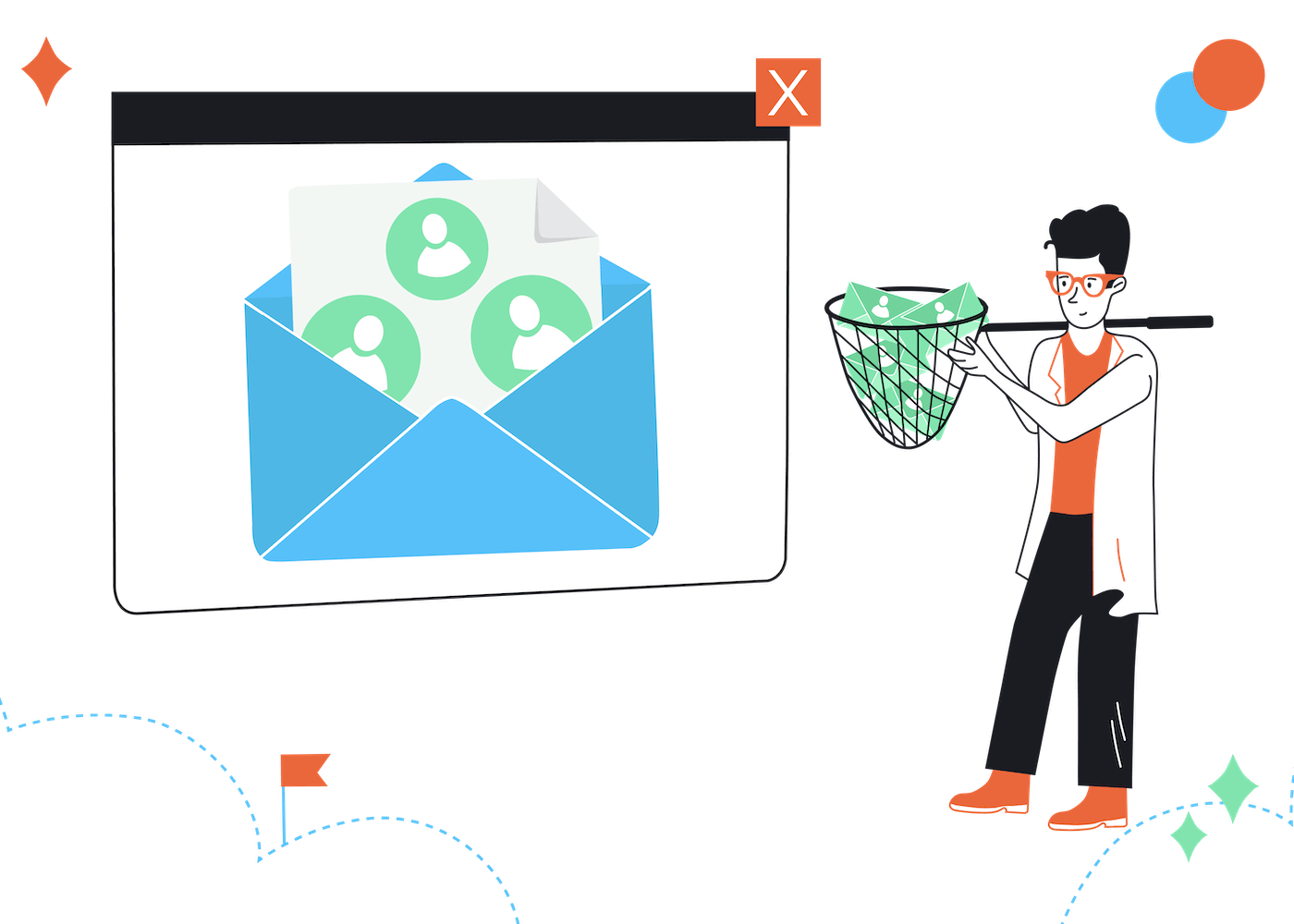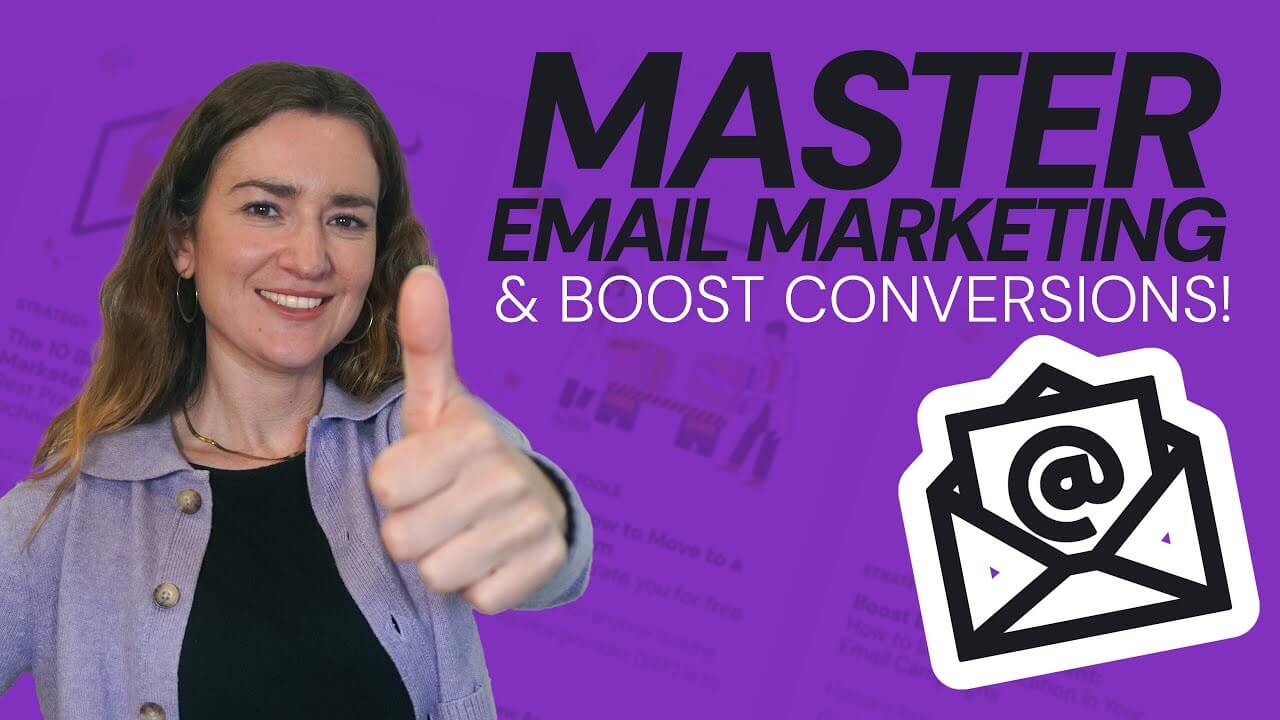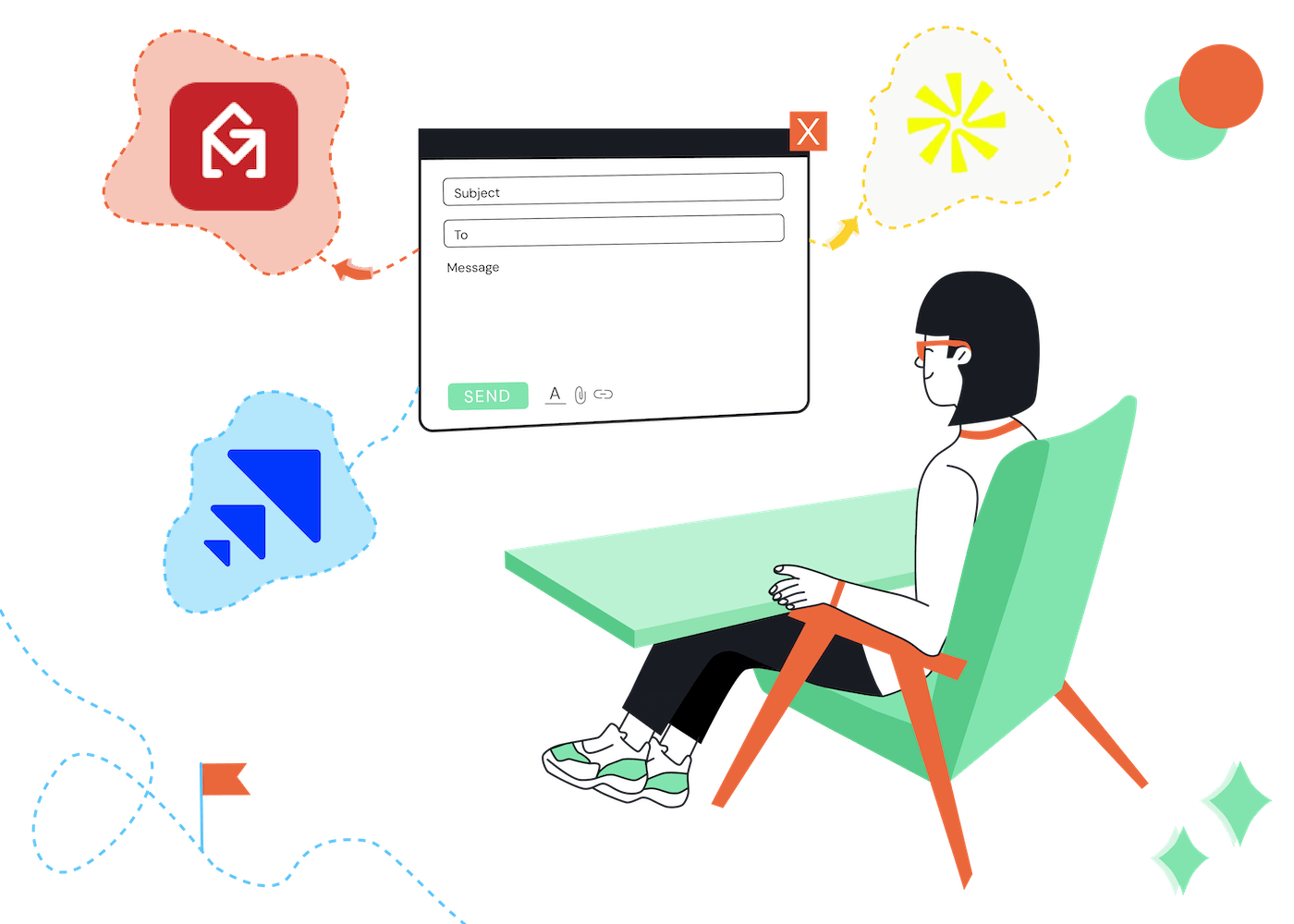I don’t know about you, but I’ve lost count of the number of emails I’ve received from businesses I don’t want to hear from.
Even though I’ve hit “Unsubscribe” so many times, the emails just keep coming. Aargh!
I won’t be naming any names here, but I definitely won’t be buying from these businesses, no matter how many times they continue to email me.
Likewise, you may hesitate to do email marketing lead generation, precisely because you don’t want your business to be known as That Annoying Email Spammer.
But in the process, you’re missing out on growing your customer base—and potentially on a lot of sales. After all, email marketing ROI can secure you as much as $36 for every dollar you spend on your email campaign.
So today, we’re going to share how to generate leads through email marketing in a way that delights rather than irritates. We’ll also reveal 10 best practices you can use to level up your email marketing and lead generation efforts in order to develop a first-class email marketing strategy (see video tutorial below).
Lead Generation Through Email Marketing Summary
If you want to do effective lead generation through email marketing, you’ll need to implement a well-thought-out strategy. Among other things, this involves identifying the ideal leads for your business and setting up an email funnel to nurture them into customers. Your strategy should also be backed by the right email software, with your emails being tested regularly to maximize conversions and sales.
What are Email Leads?
Leads are individuals who have shown some interest in your business's products or services. Accordingly, email leads are leads you’ve collected, usually through an email sign-up form (e.g. a newsletter sign-up form), as opposed to any other source. Email leads are also known as “email sales leads” or “email marketing leads.”
Individuals behind certain email leads may represent themselves in their personal capacity, while others may represent businesses. The latter is especially the case if you sell to businesses and are engaging in email marketing lead generation to get more sales.
But regardless of whether you’re doing B2C (business-to-consumer) or B2B (business-to-business) lead generation email marketing, know that email leads are not the same as customers. They haven’t bought from you yet!
Yes, they may already be somewhat interested in what you have to sell. But it’ll be your job to nurture them (more on this later) into buyers of your products or services.
What is Lead Generation?
Not sure how to generate leads with email? That’s where email lead generation comes in.
Lead generation is the process of gaining leads for your business. It’s not a step to be skipped if you want to build your list of email leads.
Because for sure, it’d be nice if email leads just fell out of the sky and landed on your email list. But life, unfortunately, doesn’t work like that. You’ll need to do email lead generation to get the quality leads coming in.
The work doesn’t stop after leads have joined your email list, either. The next step is to cultivate your relationship with them and nudge them toward buying your products or services.
In summary, lead generation email marketing will typically involve:
- Setting up email forms for users to subscribe to your email list,
- Creating lead magnets* that incentivize users to subscribe, and
- Nurturing your leads via email until they purchase from you.
*find out what a lead magnet is in #3 below
How Important is it to Have a Lead Generation Strategy?
Lead generation costs time and money. As far as possible, you’ll want such an investment to pay off—which therefore makes it important to strategize how you will proceed with email marketing for lead generation.
Your email lead generation strategy should take into account matters such as:
- Who will be overseeing and executing your strategy? Ensure that they are sufficiently trained for the job.
- For how long will you run your email lead generation strategy? Set a fixed timeframe where you will evaluate the results of your efforts at the end of the period. That said, you can extend the timeframe if your strategy is proving extremely effective!
- How much of your resources can you devote to email marketing lead generation? Allocate enough resources to allow for some experimentation, and not too few that your efforts will be doomed to fail.
Statistics show that email marketing is the most effective lead generation channel. And if done well, your email marketing campaigns can have a return on investment of as high as 3,600%!
So let’s cover some best practices for maximizing the number—and quality—of leads you generate through email:
Lead Generation Through Email Marketing – 10 Best Practices
Short on time? Check out this video where we highlight the 5 key steps. Of course, for more detailed instructions, read on!
@tooltester How to build an email list with lead magnets #emailmarketingtips #emailmarketingforbeginners #emaillistbuilding ♬ original sound – tooltester
1. Identify your ideal leads
Effective lead generation starts with knowing which leads you want to attract for your business.
After all, let’s say you run a website copywriting agency. Would email leads for a plumbing business be of any use to you in this situation? Probably not.
The ideal leads for your business would be those that fall within your target audience. If you don’t already know who your target audience is, here are some questions to help you out:
- What are the problems that your products and services help solve? Your target audience may be the people who face such problems. If you sell painkillers, for example, then people who suffer from chronic back pain may form part of your target audience.
- Who could benefit from the products and services that you offer? Alternatively, if you sell maternity dresses, then your ideal leads could be pregnant women.
- What are the demographics of your customers? What are their backgrounds like? How old are they? Are your products and services geared toward customers of a certain gender?
Use the intel you’ve gained on your target audience to pinpoint your ideal leads. You will then need to get to the point where you're working with “qualified leads”. A qualified lead is a prospect who has been generated by the marketing team, evaluated by the sales team and fits the profile of an ideal customer with the intent to buy.
With that out of the way, you can:
2. Pick a good email marketing software
Your email marketing lead generation strategy will need to be supported by the right software. There are plenty of email marketing services in the market to choose from, but we recommend shortlisting software that:
- Is easy to use: The email software should be user-friendly, helping you set up your email marketing campaigns without too much hassle.
- Contains the features you need for email marketing lead generation: If you want to do advanced email automation and lead segmentation or A/B testing, check that your email software has these features built in.
- Integrates with other software that you use: Do you use sales funnel software or a CRM for your small business? The email marketing tool you go for should offer integrations with these software providers and seamlessly send your leads to them.
- Lead scoring: Some email marketing providers have more advanced contact and list management features, such as lead scoring. This process of scoring leads can be automated, and helps you identify which prospects are “hot” or “cold”.
- Meets your budget: Consider how much you can afford to spend on email marketing lead generation every month or quarter. The cost of using your preferred email software will need to fit within this marketing budget.
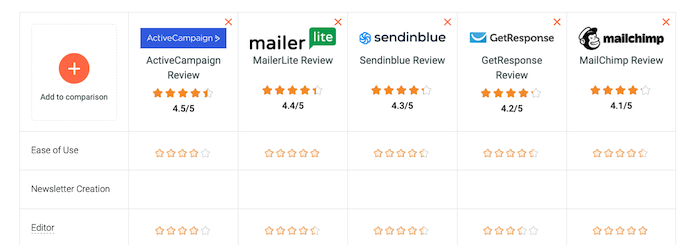
Explore our top-rated email marketing tools to help you pick the right email software for your email marketing lead generation efforts.
You’ll also be pleased to know that there are plenty of excellent free email marketing services to choose from!
>> Have you authenticated your email? Find out how.
3. Create attractive lead magnets
A lead magnet is a freebie that you offer to users in exchange for them subscribing to your email list. If done well, lead magnets can be highly effective in attracting leads—hence the term “magnet!”
Lead magnets can take various forms, such as:
- E-books
- Checklists
- Video tutorials
- Printable posters
- Quizzes
Importantly, however, the lead magnets you create should be something that your ideal leads would be interested in. Otherwise, they might not see a reason to join your email list.
For example, perhaps you’ve published a blog post that teaches photography beginners how to edit photos. In this case, a complementary lead magnet could be photography presets that beginners can apply to their edits.
If you’re generating leads through your website, it’s possible to offer the same lead magnet across your entire website. But where resources permit, try creating separate lead magnets for separate pages of your website.
Doing so can increase the relevance of your lead magnet offers—and hence the number of website visitors you convert to email subscribers.
Here is an example of our own lead magnet: a free e-book. Just click the banner below and check it out: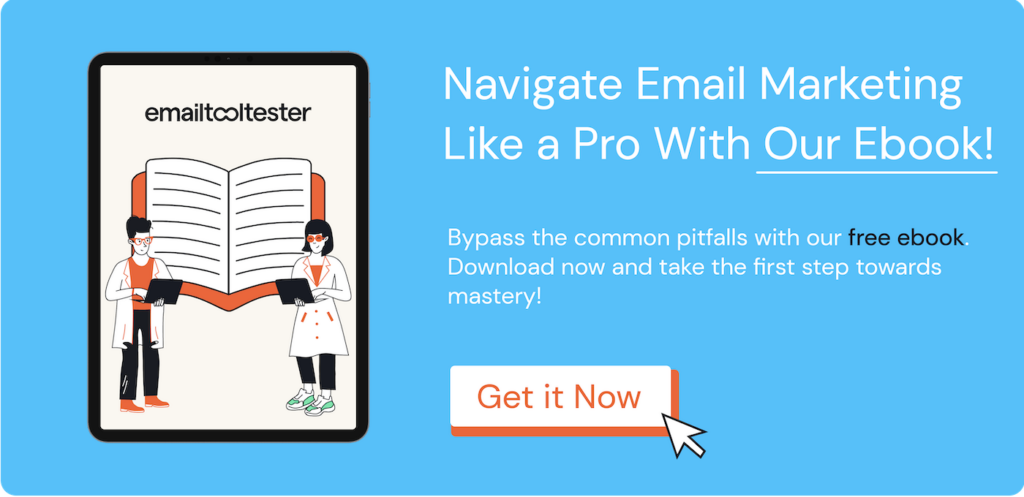 And fill out the form if you'd like a copy, of course!
And fill out the form if you'd like a copy, of course!
If you don't have a lead magnet yet, it can be a good idea to use AI to help you come up with ideas and even help you create it. Chat GPT is a powerful (and free) AI chatbot for content creation. Or just check out our long list of lead magnet ideas!
4. Set up your email forms
Now let’s talk about what you’ll use to collect email addresses: the email form!
Though dedicated online form builders are available, your email software should provide a good range of options for building and customizing email forms. For example, here are some email form templates offered by Kit.
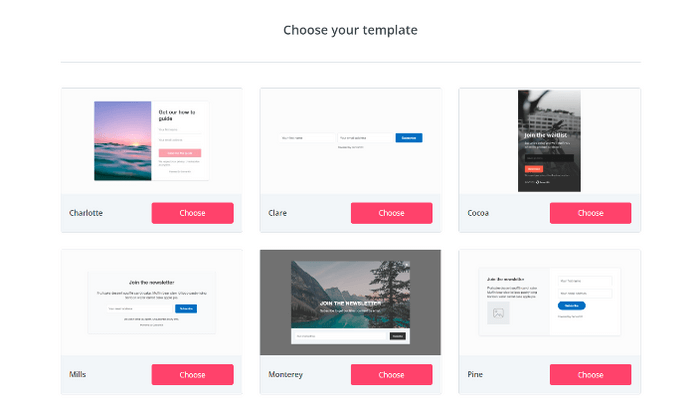
At the very least, your email form will need to contain:
- A field for users to fill out their email address, and
- A call-to-action button that users can click to indicate their interest to subscribe.
Apart from these two items, however, we suggest also including a form field for users to share their first name with you.
Why? Because this allows you to address leads by name in your emails. You’ll be surprised how adding this personal touch can generate goodwill in your business!
Your email opt in form should also display:
- An attention-grabbing heading to catch the reader’s eye and get them reading your email form
- A well-designed image of the lead magnet that you’re offering readers, and that makes them go “Gimme!”
What about the color of your email forms?
For brand consistency, the color scheme of your email forms should match that of your brand. At the same time, try to display your form headings and call-to-action buttons in striking colors that draw attention.
5. Segment your leads
As you start receiving leads through your email forms (hooray!), segment them into groups.
This way, you’ll be able to email your leads more relevant, valuable content—and nurture them toward buying your products and services instead of unsubscribing. (We’ll cover lead nurturing in more detail in #7 below.)
For example, if you are a travel film-maker, you may realize that your leads fall within two main categories:
- Travel Enthusiasts, i.e. people who are interested in traveling
- Film-Makers, i.e. people who are interested in film-making
You’d then want to segment your leads into separate “Travel Enthusiasts” and “Film-Makers” groups according to their differing interests.
From there, you can send:
- “Travel Enthusiasts” leads more emails and offers related to travel, and
- “Film-Makers” leads more emails and offers related to film-making.
(And if you find you have leads who fall within both the “Travel Enthusiasts” and “Film-Makers” segments, you can send them valuable content on both traveling and film-making!)
Check your email software for the exact process of segmenting your leads. In general, you’d need to tag your leads or add them to a subscriber group. This screenshot shows the feature for tagging contacts in ActiveCampaign:
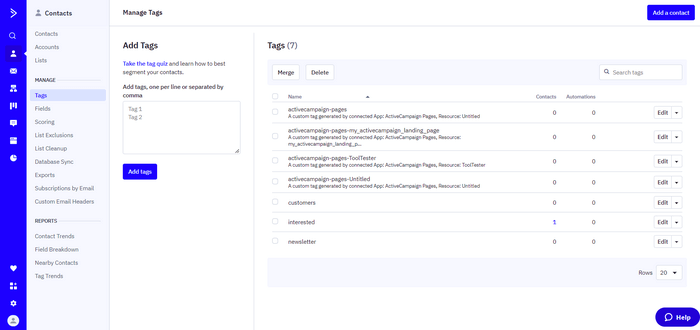
Brevo, for example, even allows for users to sign up to the list(s) that most interest them.
6. Write subject lines that entice leads to open your emails
The subject line is the first thing that leads will see when they receive your email. And if the subject line doesn’t pique their interest, they might not open it.
Some especially busy people might even delete your email right away. And you don’t want that.
Accordingly, aim to make a strong first impression with your subject line. Here are some tips:
- Keep your subject line short: Use your subject line to lead into your email—save the main meat of your email for the email body instead.
- Use a curiosity gap: Write your subject line in a way that sparks the reader’s curiosity. Then, if they want to find out more, they’ll have to open your email!
In addition, avoid using spammy words and phrases in your subject lines.
Email clients like Gmail and Outlook tend to treat emails containing words like “free,” “price” and “order now” as spam. As far as possible, omit such words from your subject lines to prevent your emails from suffering that fate.
Finally, make sure to test your subject lines before sending your emails!
7. Nurture your leads
While it’s possible for a lead to convert immediately after joining your email list, this situation doesn’t happen that often. Before you earn a sale, you generally need to nurture your leads—in other words, develop your relationship with them and prime them to buy from you. (These are known as “qualified leads”.)
You can do so by regularly sending emails that educate your leads on:
- Who you are and what your business is about
- The products and services you offer
- Who your products and services are for
- Topics related to your products and services, to establish your authority and expertise
You can also pepper relevant offers throughout your nurture email sequence, with larger offers being featured at later stages of the sequence.
However, focus on delivering value before you start pitching people to buy your stuff. Try not to appear too pushy, as this can cause them to unsubscribe.
It can also be quite troublesome to manually send emails to all your leads. That’s where you’ll use your email software to set up autoresponders and more complex automated email campaigns. Your leads will then automatically receive your nurture emails following a predetermined send schedule.
Here is an example of an autoresponder set up in Mailchimp:
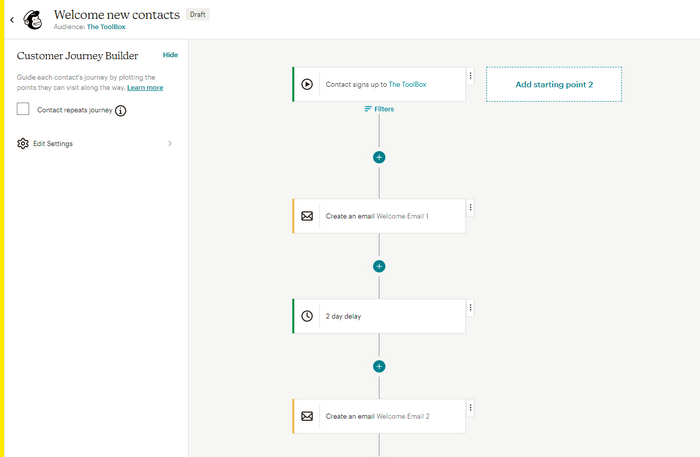
8. Test your email funnel before you launch it
Your email funnel refers to the sequence of emails that leads go through as they join your email list, get nurtured, and then (hopefully) convert. And once you’ve set your email funnel up, be sure to test it before you launch it.
You don’t want to lose sales just because there are issues with your email funnel, such as:
- Your leads receiving the wrong emails,
- Your links being broken,
- Your links directing leads to the wrong sales landing pages, and so on.
To test your email funnel, pretend that you’re a lead and sign up for your own email list. After that, check the emails that you subsequently receive. For example:
- Are you receiving emails in the right order?
- Is your email software applying the correct tags to your email address?
- Are the links in your emails working?
If everything looks good, then your email funnel is all set for use and you can roll it out. But don’t keep your email funnel static. It’s a good idea to regularly A/B-test your emails’ subject lines and copy to try and improve your conversion rate.
9. Review your email metrics regularly
How effective is your email funnel in generating and converting leads? Email metrics can provide useful insights on this. Here is a report from a newsletter we sent out with MailerLite.
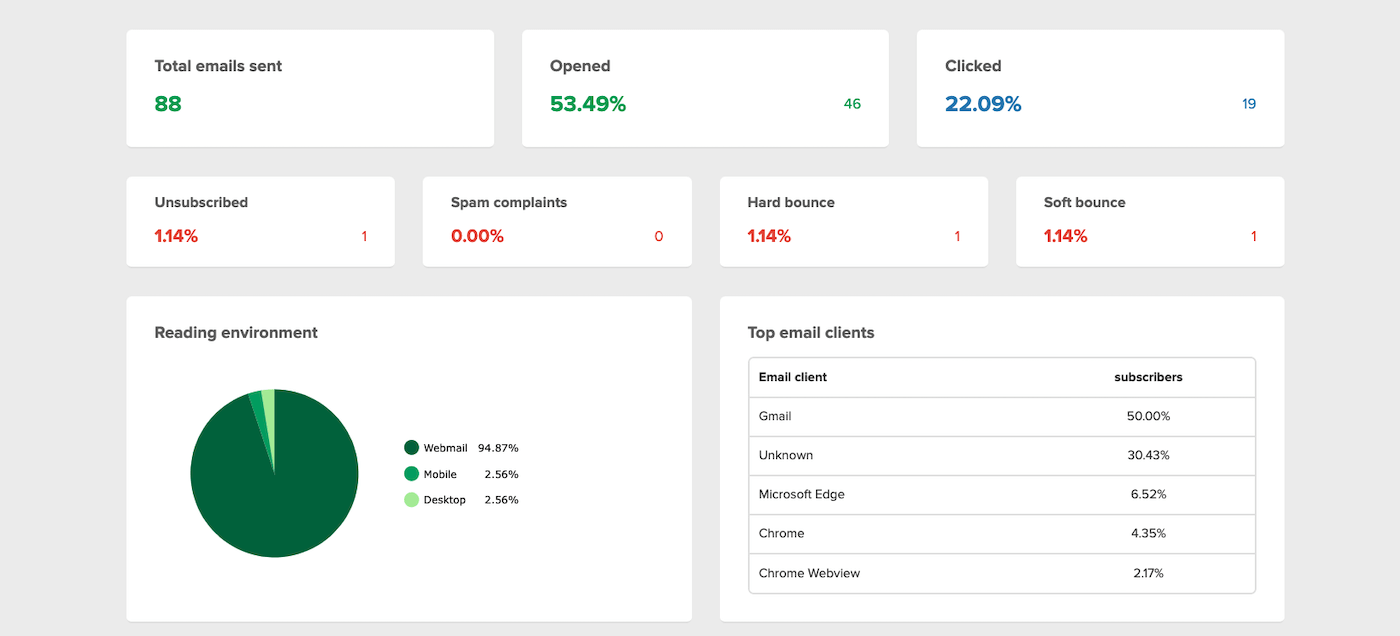
Email metrics refer to data points that indicate how leads interact with your email funnel. As you run your email funnel, keep a close eye on email metrics such as:
- Form conversion rate: How many people join your email list after being shown your email opt in form?
- Open rate: What is the percentage of leads who open your emails after receiving them? Your open rate should ideally be 15%–25% or higher depending on your industry, among other factors.
- Click rate: How often are the links in your emails being clicked?
- Sales conversion rate: What percentage of leads buy from you after receiving your emails?
- Unsubscribe rate: What percentage of leads unsubscribe after receiving your emails?
From reviewing the data, you can decide how to improve your email funnel.
For example, if the open rate of your first email tends to be low, then you might want to rework that email’s subject line.
Alternatively, you might be facing a high unsubscribe rate. In this case, you may need to include more relevant content and offers in your emails to discourage unsubscribes.
10. Do regular email list maintenance
The email addresses on your email list may have been valid when people first subscribed, but they may not remain so. This is due to reasons such as:
- People changing their email addresses: Perhaps their current inbox is too full of junk mail and they want to start afresh.
- People leaving their jobs: In this case, their email address may get deactivated when they leave the organization.
Hence, you’ll need to do regular list maintenance to keep your email list up to date and your deliverability rate high. We have put together a complete guide on email deliverability best practices, where you can find more detailed information on how to improve your deliverability rates.
Email marketing software is pretty good at helping with this. For example, if it constantly fails to deliver emails to a certain email address, it can automatically remove that email address from your email list for you by putting it on a “blocklist.”
Some email software can also tell you which leads haven’t interacted with your emails recently. Knowing which subscribers are unengaged is useful as it could suggest that their email addresses are inactive and hence candidates for removal.
But apart from these, you can also occasionally reach out to your leads and encourage them to update their email addresses with you. A good frequency for sending such emails would be once or twice a year.
What About Buying Email Leads?
Do not buy email leads. We cannot stress this enough.
Buying email leads can seem like a quick and easy solution to growing your email list: just import your purchased leads into your email software, and voilà! You now have a shiny new list of leads to market to.
But when you buy leads:
- You have no idea how these leads were obtained. Some of these leads may not have genuine email addresses, but “honeypot” ones that email clients use to detect and block spammers.
- The leads have no idea how you got their email addresses either. Their next move might be to unsubscribe or report your email as spam. Either way, you’ve just wasted money buying that lead.
- You risk breaching anti-spam laws. If you’re buying leads, chances are they haven’t consented to being on your email list—check out the laws around email marketing here.
- You may be killing your deliverability rate. Having your emails marked as spam, whether by email clients or humans, can negatively impact your sender reputation score. You’ll find it harder to get your emails into your leads’ inboxes as a result.
Needless to say, buying email leads can do your business more harm than good. Resist the temptation to do so as your list won't be made up of quality leads, as it should be.
Building your email list the legitimate way definitely takes more work and time, but you’ll improve the quality of your leads and likely experience higher conversion rates. Not ending up on the wrong side of the law should also be a good incentive.
Email Marketing Lead Generation: Conclusion
Email is a fantastic tool for generating leads, gaining more customers, and boosting your bottom line. But there are right methods and wrong methods of using email to generate leads.
Wrong methods include:
- Having no email lead generation strategy at all,
- Buying email leads, and
- Sending mass emails without tailoring them to your leads’ needs and interests.
Far from helping you generate good leads, these methods are more likely to generate you a bad rep and turn people off purchasing from you.
In contrast, the right methods of doing email marketing lead generation would be to:
- Know how to generate email leads that are valuable for your business,
- Send these leads useful, valuable content, and
- Build your relationship with them to facilitate conversions when you present relevant and attractive offers.
Apart from these best practices, you’ll also need to invest in the best email software for your overall email marketing strategy!
If you don’t already have email software or are looking to switch providers, browse our list of the best email marketing services to give your email marketing lead generation efforts the best chances of success.
If you have any questions, pop them in the comments section below, and I’ll do my best to help!
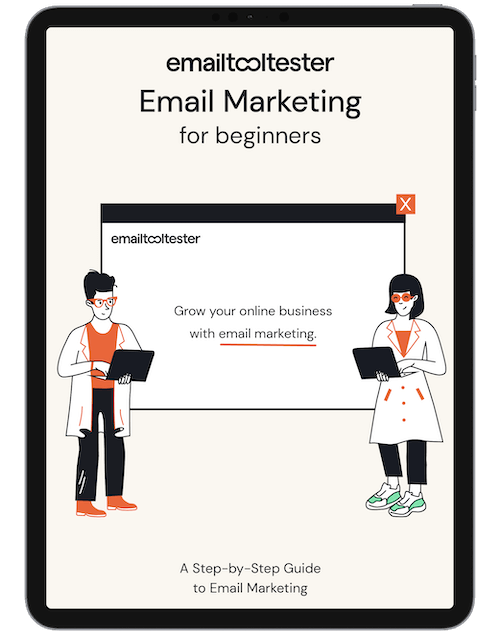
Email Marketing Ebook: Beginner's Guide
Sign up to receive your free copy and avoid common mistakes!
We keep our content up to date
06 Feb 2025 - Added email marketing strategy video
18 Apr 2024 - Added TikTok video
07 Feb 2023 – Small addition about AI tools
Our Methodology
This article has been written and researched following our EmailTooltester methodology.
Our Methodology